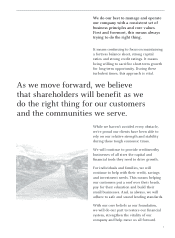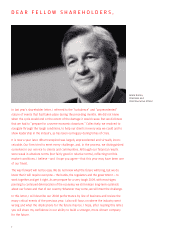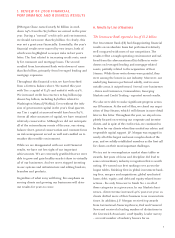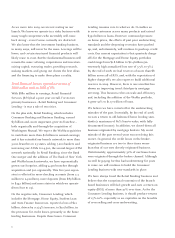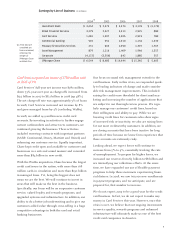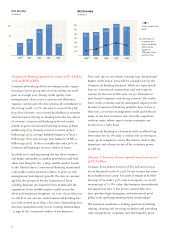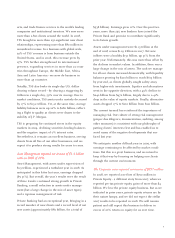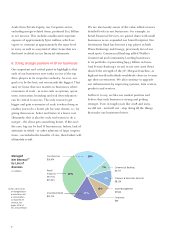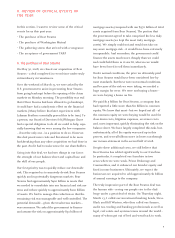JP Morgan Chase 2008 Annual Report Download - page 13
Download and view the complete annual report
Please find page 13 of the 2008 JP Morgan Chase annual report below. You can navigate through the pages in the report by either clicking on the pages listed below, or by using the keyword search tool below to find specific information within the annual report.11
Our people across the business – together with our
experts in systems, marketing, legal, finance, audit and
human resources – did an outstanding job executing
this transaction, making it possible for us to take this
important strategic step.
C. The gathering storm arrived with a vengeance —
and how JPMorgan Chase fared
In 2008, Bear Stearns collapsed; Lehman Brothers
declared bankruptcy; Fannie Mae and Freddie Mac
were placed into government conservatorship; the
government assumed majority ownership of AIG;
Merrill Lynch sold itself to Bank of America; Wells
Fargo took over a struggling Wachovia; IndyMac and
WaMu went into receivership by the Federal Deposit
Insurance Corporation; Countrywide and the U.S.
mortgage business virtually collapsed; the two remain-
ing major investment banks, Goldman Sachs and
Morgan Stanley, became bank holding companies;
around the globe, French, British, Swiss and German
banks were rescued by their governments; and the
world entered the sharpest, most globalized downturn
since the Great Depression.
As for JPMorgan Chase, we had large credit and opera-
tional exposures in virtually every situation mentioned
above, affecting nearly every line of business. Our
firm’s management teams, credit officers, risk officers,
and legal, finance, audit and compliance teams worked
tirelessly to protect the company. We believe it is a
considerable sign of strength that we could manage
through such extraordinary problems with minimal
losses to the company.
We avoided many critical problems that would have
made things far worse
In last year’s letter, we focused on our problems –
including mortgage issues in Retail Financial Services
and write-downs in the Investment Bank of leveraged
loans and mortgage securities. Those issues cost us a
considerable amount of money in 2008 and will contin-
ue to cost us money in 2009. But it also is instructive
to focus on how we were able to avoid certain prob-
lems, control the damage and minimize the cost.
In 2008:
• We essentially stayed away from sponsoring struc-
tured investment vehicles (SIV) because we viewed
them as arbitrage vehicles with plenty of risk and a
limited business purpose. We also minimized our
financing to SIVs for the same reasons, and back in
2005, we sold the only small SIV we had sponsored.
• We didn’t write option ARMs (adjustable rate
mortgages) because we did not think they were a
consumer-friendly product. Although we made
plenty of mistakes in the mortgage business, this
was not one of them.
• We substantially cut back on subprime early in the
crisis. While subprime mortgages cost us nearly $1
billion in 2008, we avoided far worse results because
we had significantly reduced our exposures in 2006.
This was true both in the mortgage business and in
the Investment Bank.
• We never built up the structured finance business.
While we are a large player in the asset-backed
securities market, we deliberately avoided the struc-
tured collateralized debt obligation (CDO) business
because we believed the associated risks were too
high. Structured finance in its most complicated
forms, such as “CDO-squared,” has largely disap-
peared after unleashing a myriad of problems on
the financial system. They will not be missed.
• We did not unduly leverage our capital, nor did we
rely on low-quality forms of capital. We always had
high targets of 8% to 8.5% Tier 1 capital. We always
believed in “high-quality” capital, which, among
other things, means conservative accounting, strong
loan loss reserves and a high component of tangible
common equity. The higher the quality of capital,
the more prepared one is for tough times.
• We maintained a high level of liquidity – and were
always prepared for unexpected draws (i.e., collateral
calls). Strong liquidity is a constant for us. The fact
that we have total deposits of $1 trillion across our
retail and wholesale businesses positions the firm
advantageously overall and has helped us weather


